| کد مقاله | کد نشریه | سال انتشار | مقاله انگلیسی | نسخه تمام متن |
|---|---|---|---|---|
| 6401288 | 1330881 | 2015 | 9 صفحه PDF | دانلود رایگان |
- Maximum all-trans-lycopene concentration was attained with ethyl acetate at 400Â W, with 24Â kJ equivalents (1Â min treatment).
- All-trans-lycopene yields were significantly higher with microwave-assisted versus conventional extraction.
- Microwave-assisted extraction appeared to substantially disrupt tomato cell structure, possibly improving lycopene yield.
Lycopene is the primary carotenoid in tomato peels, a processing byproduct, and can be used as a natural color or bioactive ingredient. Unfortunately, extractions are inefficient as lycopene is extremely nonpolar and susceptible to degradation. As a rapid technique, microwave-assisted extraction (MAE) potentially offers efficient lycopene recovery. Thus, the objectives of this research were to: 1) optimize MAE of lycopene from tomato peels and 2) evaluate the effect of treatment on all-trans and isomer yields. Response surface methodology (RSM) was employed to optimize lycopene extraction with solvent ratio solid-liquid ratios, microwave power, and delivered energy equivalents as factors. High performance liquid chromatography with a diode array detector (HPLC-DAD) was used for isomer separation and quantification. Optimum MAE conditions were determined as: 0:10 solvent ratio at 400Â W with a yield of 13.592Â mg/100Â g of extracted all-trans-lycopene. RSM suggested that ethyl acetate was a better MAE solvent for lycopene recovery as compared to hexane, which overall extracted less lycopene. HPLC-DAD indicated that MAE significantly improved all-trans and total lycopene yields, while conventional extraction demonstrated higher proportions of cis-isomer yields. Additionally, electron micrographs showed that significant structural disruption occurred in MAE-treated samples, possibly allowing for the improved lycopene extraction.
Journal: LWT - Food Science and Technology - Volume 62, Issue 1, Part 1, June 2015, Pages 160-168
